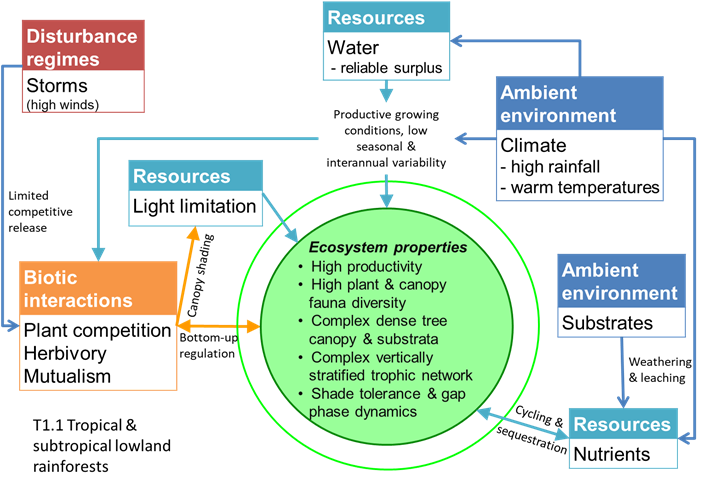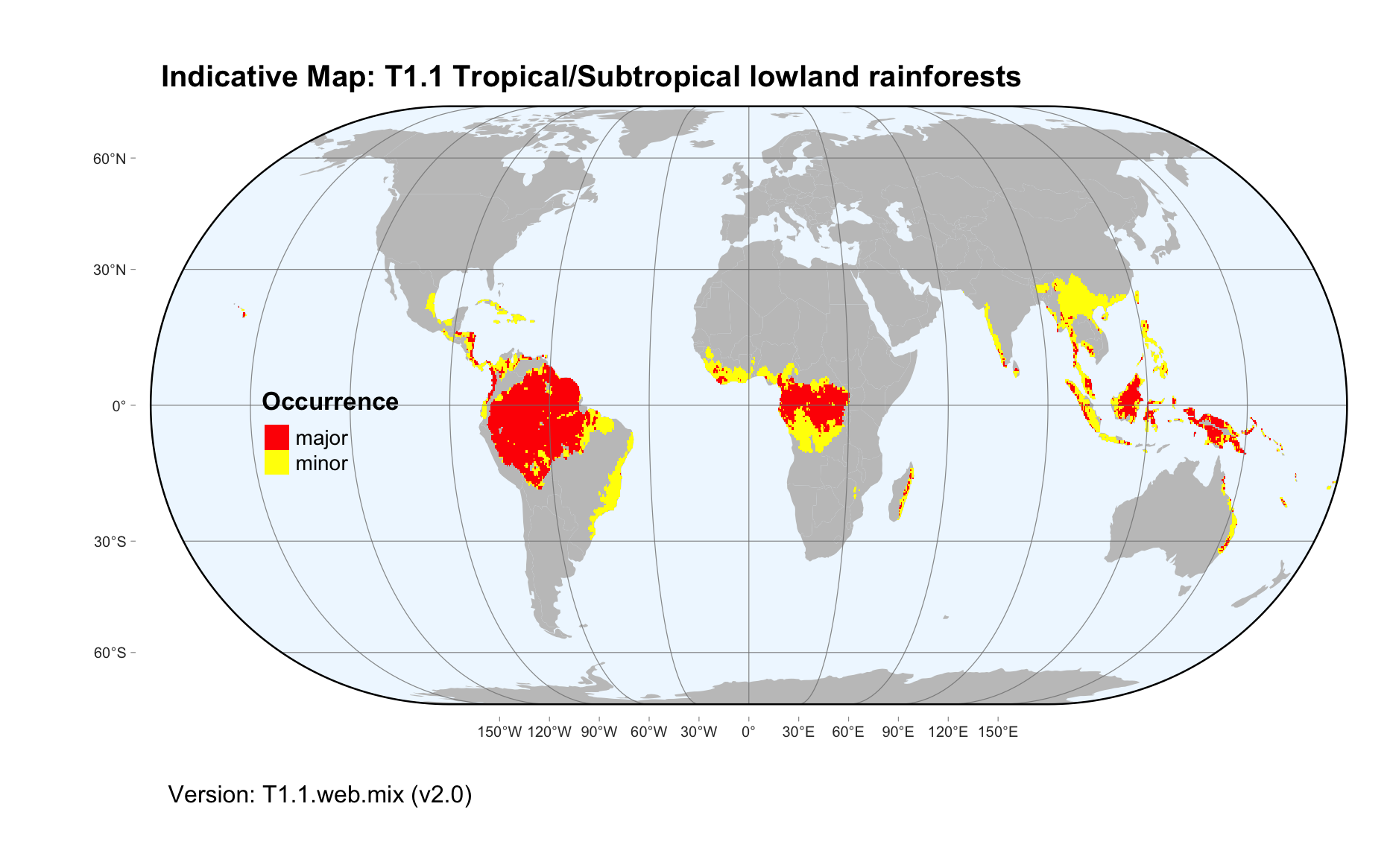Global ecosystem typology
Alternative site for the Global ecosystem typology with additional information for ecosystem profiles and indicative maps.
This site is maintained by jrfep
T1.1 Tropical/Subtropical lowland rainforests
Biome: T1. Tropical-subtropical forests biome
Contributors:
(texts)
A huge diversity of species occupy niches within a complex vertically-layered structure of plant forms. High productivity is fuelled by rapid-growing plants including buttressed trees, bamboos, epiphytes, lianas and ferns. Forest canopies sustain moist soils and abundant leaf litter decomposed by fungi and bacteria. High diversity of invertebrates at all levels of the forest supports diverse vertebrate life forms, particularly mammals and birds, which play critical roles in plant dispersal and pollination. Conditions near the equator are stable and humid year-round (up to 6000 mm rain per annum), but become more seasonal with mild winter frosts in the subtropics.
Key Features
Tall closed-canopy evergreen forests in warm wet climates, phylogenetically & functionally highly diverse life forms.
Overview of distribution
Global wet tropics & subtropics.
Profile versions
- v1.0 (2020-01-20): DA Keith
- v2.0 (2020-06-15): DA Keith; KR Young; RT Corlett
- v2.01 ():
- v2.1 (2022-04-06): DA Keith; KR Young; RT Corlett Full profile available at official site
Main references
Selected references for this functional group:
Corlett RT, Primack RB (2011) Tropical Rain Forests: An ecological and biogeographical comparison. Second edition. Wiley-Blackwell, Chichester.
Ashton PS, Seidler R (2014) On the forests of tropical Asia: lest the memory fade Kew Publishing: Kew
Diagrammatic assembly model

Maps
Maps are indicative of global distribution patterns are not intended to represent fine-scale patterns. The maps show areas of the world containing major (coloured red) or minor occurrences (coloured yellow) of each ecosystem functional group. See general notes on maps.
There are 2 alternative versions of the indicative map for this functional group, please compare description and sources below.
T1.1.IM.mix_v2.0
Datasets
- Resolve-Ecoregions-2017
- IBRA-v7
- EarthEnv-LandCover-v1.0
Map references
Dinerstein E, Olson D, Joshi A, Vynne C, Burgess ND, Wikramanayake E, Hahn N, Palminteri S, Hedao P, Noss R, Hansen M, Locke H, Ellis EE, Jones B, Barber CV, Hayes R, Kormos C, Martin V, Crist E, Sechrest W, Price L, Baillie JEM, Weeden D, Suckling K, Davis C, Sizer N, Moore R, Thau D, Birch T, Potapov P, Turubanova S, Tyukavina A, de Souza N, Pintea L, Brito JC, Llewellyn Barnekow Lillesø JP, van Breugel P, Graudal L, Voge M, Al-Shammari KF, Saleem M (2017) An Ecoregion-Based Approach to Protecting Half the Terrestrial Realm, BioScience 67: 534–545. DOI:10.1093/biosci/bix014. Data-set available on-line
Department of Agriculture, Water and the Environment (2012) Interim Biogeographic Regionalisation for Australia v. 7 (IBRA) ESRI shapefile
Tuanmu, M.-N. and W. Jetz (2014) A global 1-km consensus land-cover product for biodiversity and ecosystem modeling Global Ecology and Biogeography 23(9):1031–1045 DOI:10.1111/geb.12182
T1.1.web.mix_v2.0

Datasets
- EarthEnv-LandCover-v1.0
- IBRA-v7
- Resolve-Ecoregions-2017
Map references
Tuanmu, M.-N. and W. Jetz (2014) A global 1-km consensus land-cover product for biodiversity and ecosystem modeling Global Ecology and Biogeography 23(9):1031–1045 DOI:10.1111/geb.12182
Department of Agriculture, Water and the Environment (2012) Interim Biogeographic Regionalisation for Australia v. 7 (IBRA) ESRI shapefile
Dinerstein E, Olson D, Joshi A, Vynne C, Burgess ND, Wikramanayake E, Hahn N, Palminteri S, Hedao P, Noss R, Hansen M, Locke H, Ellis EE, Jones B, Barber CV, Hayes R, Kormos C, Martin V, Crist E, Sechrest W, Price L, Baillie JEM, Weeden D, Suckling K, Davis C, Sizer N, Moore R, Thau D, Birch T, Potapov P, Turubanova S, Tyukavina A, de Souza N, Pintea L, Brito JC, Llewellyn Barnekow Lillesø JP, van Breugel P, Graudal L, Voge M, Al-Shammari KF, Saleem M (2017) An Ecoregion-Based Approach to Protecting Half the Terrestrial Realm, BioScience 67: 534–545. DOI:10.1093/biosci/bix014. Data-set available on-line
Check: the Glossary / Profile structure / the public document